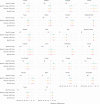Sensitivity Analysis of Excess Mortality due to the COVID-19 Pandemic
- PMID: 35600716
- PMCID: PMC9115405
- DOI: 10.1111/padr.12475
Sensitivity Analysis of Excess Mortality due to the COVID-19 Pandemic
Abstract
Estimating excess mortality is challenging. The metric depends on the expected mortality level, which can differ based on given choices, such as the method and the time series length used to estimate the baseline. However, these choices are often arbitrary, and are not subject to any sensitivity analysis. We bring to light the importance of carefully choosing the inputs and methods used to estimate excess mortality. Drawing on data from 26 countries, we investigate how sensitive excess mortality is to the choice of the mortality index, the number of years included in the reference period, the method, and the time unit of the death series. We employ two mortality indices, three reference periods, two data time units, and four methods for estimating the baseline. We show that excess mortality estimates can vary substantially when these factors are changed, and that the largest variations stem from the choice of the mortality index and the method. We also find that the magnitude of the variation in excess mortality is country-specific, resulting in cross-country rankings changes. Finally, based on our findings, we provide guidelines for estimating excess mortality.
Keywords: COVID‐19; country comparison; excess mortality.
© 2022 The Authors. Population and Development Review published by Wiley Periodicals LLC on behalf of Population Council.
Figures








References
-
- Aburto, Jose Manuel , Kashyap Ridhi, Schöley Jonas, Angus Colin, Ermisch John, Mills Melinda C., and Dowd Jennifer Beam. 2021. “Estimating the Burden of the COVID‐19 Pandemic on Mortality, Life Expectancy and Lifespan Inequality in England and Wales: A Population‐Level Analysis.” Journal of Epidemiology and Community Health, 75: 735–740. 10.1136/jech-2020-215505. - DOI - PMC - PubMed
-
- Andreev, Evgueni M. , and Shkolnikov Vladimir M.. 2010. “Spreadsheet for Calculation of Confidence Limits for Any Life Table or Healthy‐Life Table Quantity.” MPIDR Technical Report TR‐2010‐005. 10.4054/MPIDR-TR-2010-005. - DOI
-
- Barbieri, Magali , Wilmoth John R., Shkolnikov Vladimir M., Glei Dana, Jasilionis Domantas, Jdanov Dmitri, Boe Carl, Riffe Timothy, Grigoriev Pavel, and Winant Celeste. 2015. “Data Resource Profile: The Human Mortality Database (HMD).” International Journal of Epidemiology 44(5): 1549–1556. 10.1093/ije/dyv105. - DOI - PMC - PubMed
-
- Basellini, Ugofilippo , Alburez‐Gutierrez Diego, Del Fava Emanuele, Perrotta Daniela, Bonetti Marco, Camarda Carlo G., and Zagheni Emilio. 2021. “Linking Excess Mortality to Mobility Data during the First Wave of COVID‐19 in England and Wales.” SSM – Population Health 14(June): 100799. 10.1016/j.ssmph.2021.100799. - DOI - PMC - PubMed
LinkOut - more resources
Full Text Sources
